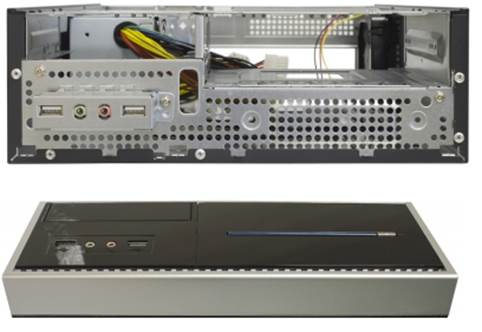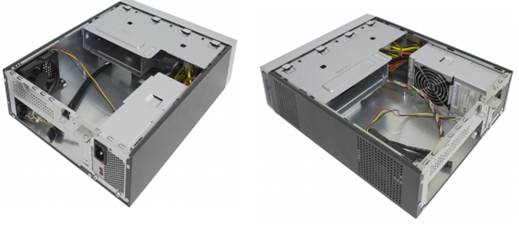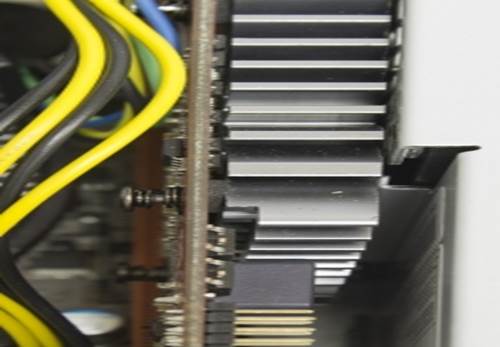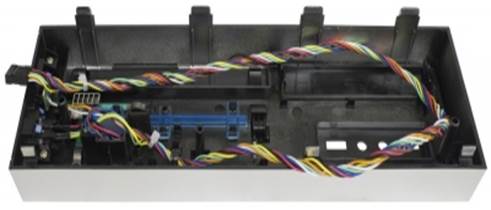Foxconn RS-338 (L)
Based on the same platform as the Foxconn
RS-224, this model differed only in some minor nuances.

Product
Image
Most of the things are about the exterior
design. The Foxconn RS-338 (L) looks better than the RS-224 but there is no
functional difference between them.

The
front ports and slots
The connectors on the front include
headphone and microphone slots and a pair of USB ports. Sample computer casing
provides two external disk bays (one for 3.5-inch devices and one for 5.25-inch
devices).

Power
and Reset Buttons
The Power and Reset buttons are located on shorter
side of the case. There is a red LED indicator in the middle shows information
about disk activities.

The
stand
Like the RS-224 that has been tested
previously, the RS-338 (L) can also stand upright. However, the accompanying
support (similar to the RS-224) is not so tight. They can easily slip off if
you lift up or come apart if you hit it accidentally.

The
product observed from behind
When you look at the back of the product we
will see the difference in size compared to the Antec model discussed above.
Foxconn’s is higher (when standing upright) than the width of the PSU placed in
its usual position near the back of the shell. Foxconn’s is also significantly
larger.
As opposed to the Foxconn RS-224, the RS-338
(L) model only supports one low profile expansion card. Unfortunately, the
splints for the expansion slots in the back cannot be reused.

The
accompanying accessories
The accessories have become few since our
test in the RS-224. The RS-338 (L) is packaged with the support for the
vertical installation, wires, and some screws. There is no corner adapter for
the optical drive connector, like the one we saw in the RS-224 and no user
manual comes with those accessories.

The
steel cover
The steel cover of this computer case model
is thin (0.5 mm) like the metal sheets used to make the rest of the case. It is
the thinnest sheet metal of the four products in this review.

The
space inside
The space inside is much more than the
Antec ISK 310-150’s, and the assembly process is similar to the Foxconn RS-224
with all of its high and low positions.

The
drive bays
The mounting frame allows installing a desktop
optical drive on the 5.25-inch bay and a card reader into an open 3.5-inch bay.
As with the RS-224, the 3.5-inch bay gap can accommodate a 3.5-inch hard drive,
but cannot be plugged into the cable so that there is no gap between the disc
and the PSU slot.

Expansion
card mounting position
There is another limit related to the PSU
here. It is related to the height of the expansion card components. The small
heatsink on our passively cooled Radeon HD 6450 is the maximum since it is mounted
against the PSU next to the last fan.
On one hand, it is good because the passive
cooling system on our graphics card was in fact converted into the active one,
but the expansion card with the higher parts will not fit such a limited
mounting space.

The
layout of the mainboard components
The layout of the components of the
motherboard is completely different from our previous test, so the overall ventilation
process is better here. CPU coolers are now the center of the space inside,
between the expansion cards, the rear case, optical drive and the fan on the
side, and there is a large distance from each component. This allows the
installation of a larger cooling system than Intel’s packaged cooling device in
both width and height. And you will not encounter any problems in connecting
the I/O ports on the front because the cables are long enough to wrap around
the heatsink of the CPU cooler.
However, there are limitations due to the
layout of the mainboard components. High heatsinks on the memory modules made us
impossible to get an optical drive installed. Either way, we do not think overclocker-friendly
modules with such heatsink are appropriate for compact mini-ITX systems.

Cables
connecting buttons and indicators
The buttons and indicators of the computer case
is connected via a cable with a single header. It is compatible with our mainboard,
so all the button and indicator functions are working fine, but you may
experience issues with motherboards with non-standard wiring.
Optical drives wrap before flight, so the
difference between the front matte surface of the drive with the glossy metal sheets
to create the computer case will not show. However there is no patch to
decorate the open 3.5-inch slots.

The
product’s fan
The Foxconn RS-338 (L) is cooled by an
exhaust 80x80x25mm fan. Its low required energy (0.1 A) showed a low level of
noise. Indeed, its speed is not higher than 1,500 RPM. Fans with such forms do
not create any discomfort at any sound level to speed.

Complete
product’s image
The Foxconn RS-338 model (L) looks pleasant
to the eyes. Its black front is made more vivid by the blue light line of the
power indicator. The Power and Reset buttons are also blue. We are only
slightly dissatisfied with the front glossy surface which is very easy to leave
fingerprint smudges when being touched, but it is the inevitable downside of an
beautiful external design.
Advantages
·
Easy to install
·
Efficient ventilation
·
Quiet Activities
·
There is a slot for an external 3.5-inch device
·
The exterior designed beautiful
·
Affordable
Disadvantages
·
Thin metal chassis
·
Not compatible with 2.5-inch hard disks and
there is only a slot for internal HDDs
·
The PSU fan may prevent you from installing an
expansion card with great cooling system
·
The splint for expansion slot can only be used
once only.
Foxconn RS-338 (L)’s technical standards
·
Dimensions in mm: 282x95x388
·
Compatibility: Mini-ITX
·
External slot: 1x5.25", 1x3.5"
·
Internal slot: 1x3.5"
·
External ports: 2 x USB 2.0, 2 audio jacks
·
Fan: 1x80 mm